At a small café in Sydney’s north-west, Changhyun Lee is making Korean rice cakes also known as 'tteuk', using skills handed down through generations.
"Growing up in Korea, I learned to make rice cakes by helping my parents in their rice cake store. Later, I oversaw production in a rice cake business in Daechi-dong (a suburb of Seoul)," says Lee.
Migrating to Australia in 2010, Lee, 52, dreamed of setting up a rice cake venture in Sydney, to continue his parents' legacy.
Three years ago he achieved that goal.
He now makes dozens of varieties of colourful tteuk, which are are in high demand for mid-Autumn or Moon Festival celebrations this weekend.

Specialty songpyeon are made for the mid-Autumn Festival. Source: Supplied / Siroo Rice Cake Cafe
"Rice cakes don’t last more than a day, so people want them fresh.
"Rice cakes have also become more popular in recent years thanks to Korean dramas, which feature rice cakes and traditional Korean cooking," she says.
Despite honing his craft over the past 30 years, Lee only makes the special 'songpyeon' rice cakes once a year, during the mid-Autumn or Moon Festival, known as Chuseok in Korea.
Songpyeon are different shapes and sizes. Some are diamond-shaped and may be filled with soybeans, cowpeas, chestnuts, jujubes, dates, red beans, sesame seeds or honey.

Jenny Lee (left) with her mother, Esther Ko. Source: SBS News / Youssef Saudie
Chuseok is one of the biggest holidays in Korea and is sometimes referred to as 'Korean Thanksgiving' because families gather to celebrate and pay respect to elders and ancestors.
"In Korea, the festival is celebrated mid-autumn when all the grains are harvested. So, songpyeon traditionally were made from very fresh ingredients," Lee says.
"But because not all the traditional ingredients are available in Australia, and not all our customers are Korean, so we have adapted songpyeon to local tastes."
Around 40 per cent of Siroo’s customers are non-Korean, and the Lee family expects to sell up to 20,000 tteuk this year.
History of rice cakes
The first references to tteok appears in books about wars involving China and Korea 2,500 years ago.
The first and oldest form is sirutteok, which is a steamed rice cake.
Lee has honed his rice cake-making skills since setting up his own venture, Siroo Rice Cake Cafe in West Ryde.
"So, a lot of people now come in to try our rice cakes," says Jenny.
The Mid-Autumn or Moon Festival is usually held around the 15th day of the eighth lunar month in the Chinese calendar.
It is considered the second most important in the Asian calendar after Lunar New Year.
Across Asia, families in Korea, China, Taiwan, Malaysia and Vietnam celebrate with gifts of sweet treats, and attend lantern parades and stage shows.
In Japan, tsukimi or 'moon viewing' rice dumplings are also popular.
In China, mooncakes are often filled with sweet or savoury ingredients including red bean paste, minced pork, salted egg or crushed nuts.

Joey Leung making mooncakes in Melbourne. Source: SBS News / Shan Kou
A way to share heritage
"The Moon Festival is the busiest time of year and I make most of my annual income in September," she says.
Leung migrated from Hong Kong 10 years ago and started her business in 2020 while out of work during COVID-19, selling eclairs and madeleines.
Her pastries were popular among Hong Kong migrants who soon began asking for mooncakes, too.
"This is a cake you need to try, it is truly a labour of love," the 42-year-old says.

Joy Jaune Mooncakes. Source: SBS News / Shan Kou
"I also have customers coming from Hong Kong who take my mooncakes back to Hong Kong for their friends and family as a souvenir," she says.
Leung says locally made mooncakes are also an important way to share her heritage.
"Mooncakes are ambassadors of Chinese culture. And all our moon cakes are made with love, using fresh local ingredients."
One of Joy Jaune’s most popular mooncakes is a custard filling made with 'salted egg yolk' wrapped by a unique short-crust pastry.

Joey Leung with a gift box of mooncakes. Source: SBS News / Shan Kou
Two new flavours this year are made from green teas: matcha and hojicha.
"Also, life is harder this year, so we are also offering a special discount for people who are struggling, so that they can all share mooncakes."

Changhyun Lee with his daughter, Jenny. Source: SBS News / Youssef Saudie
"This recipe was passed down from my dad and I will pass it on to my daughters to continue the legacy," Lee says.
"So, I am very proud!"
This story was produced in collaboration with SBS Chinese and SBS Korean.












